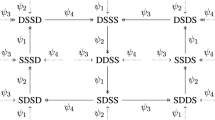Abstract
We give a constructive method for realising an arbitrary directed graph (with no one-cycles) as a heteroclinic or an excitable dynamic network in the phase space of a system of coupled cells of two types. In each case, the system is expressed as a system of first-order differential equations. One of the cell types (the p-cells) interacts by mutual inhibition and classifies which vertex (state) we are currently close to, while the other cell type (the y-cells) excites the p-cells selectively and becomes active only when there is a transition between vertices. We exhibit open sets of parameter values such that these dynamical networks exist and demonstrate via numerical simulation that they can be attractors for suitably chosen parameters.











Similar content being viewed by others
Notes
We refer to a “(weak) heteroclinic network (in phase space)” simply as a “heteroclinic network” for the remainder of the paper.
References
Aguiar, M.A.D., Ashwin, P., Dias, A.P.S., Field, M.: Dynamics of coupled cell networks: synchrony, heteroclinic cycles and inflation. J. Nonlinear Sci. 21, 271–323 (2011)
Ashwin, P., Field, M.: Heteroclinic networks in coupled cell systems. Arch. Ration. Mech. Anal. 148(2), 107–143 (1999)
Ashwin, P., Borresen, J.: Encoding via conjugate symmetries of slow oscillations for globally coupled oscillators. Phys. Rev. E 70(2), 026203 (2004)
Ashwin, P., Karabacak, O., Nowotny, T.: Criteria for robustness of heteroclinic cycles in neural microcircuits. J. Math. Neurosci. 1, 13 (2011)
Ashwin, P., Lavric, A.: A low-dimensional model of binocular rivalry using winnerless competition. Phys. D 239, 529–536 (2010)
Ashwin, P., Postlethwaite, C.: On designing heteroclinic networks from graphs. Phys. D 265, 26–39 (2013)
Ashwin, P., Postlethwaite, C.: Quantifying noisy attractors: from heteroclinic to excitable networks (2015, in preparation)
Ashwin, P., Orosz, G., Wordsworth, J., Townley, S.: Dynamics on networks of clustered states for globally coupled phase oscillators. SIAM J. Appl. Dyn. Syst. 6(4), 728–758 (2007)
Bick, C., Rabinovich, M.I.: On the occurrence of stable heteroclinic channels in Lotka–Volterra models. Dyn. Syst. 25, 97–110 (2010)
Ermentrout, G.B., Terman, D.H.: Mathematical Foundations of Neuroscience Springer Series: Interdisciplinary Applied Mathematics, vol. 35. Springer, Berlin (2010)
Field, M.: Heteroclinic networks in homogeneous and heterogeneous identical cell systems. J. Nonlinear Sci. 25(3), 779–813 (2015)
Hütt, M.-T., Jain, M.K., Hilgetag, C.C., Lesne, A.: Stochastic resonance in discrete excitable dynamics on graphs. Chaos Solitons Fractals 45, 611–618 (2012)
Ilyashenko, Yu., Negut, A.: Invisible parts of attractors. Nonlinearity 23, 1199 (2010)
Izhikevich, E.M.: Dynamical Systems in Neuroscience: The Geometry of Excitability and Bursting. MIT Press, Cambridge (2007)
Kinouchi, O., Copelli, M.: Optimal dynamical range of excitable networks at criticality. Nat. Phys. 2, 348–351 (2006)
Kirk, V., Postlethwaite, C.M., Rucklidge, A.M.: Resonance of heteroclinic networks. SIADS 11, 1360–1401 (2012)
Kirk, V., Silber, M.: A competition between heteroclinic cycles. Nonlinearity 7, 1605–1621 (1994)
Komarov, M.A., Osipov, G.V., Suykens, J.A.K.: Sequentially activated groups in neural networks. Europhys. Lett. 86(6), 60006 (2009)
Kopell, N.J., Gritton, H.J., Whittington, M.A., Kramer, M.A.: Beyond the connectome: the dynome. Neuron 83, 1319–1328 (2014)
Krupa, M.: Robust heteroclinic cycles. J. Nonlinear Sci. 7(2), 129–176 (1997)
Lindner, B., Garcia-Ojalvo, J., Neiman, A., Schimansky-Geier, L.: Effects of noise in excitable systems. Phys. Rep. 392, 321–424 (2004)
Neves, F.S., Timme, M.: Computation by switching in complex networks of states. Phys. Rev. Lett. 109, 018701 (2012)
Rabinovich, M.I., Volkovskii, A., Lecanda, P., Huerta, R., Abarbanel, H.D.I., Laurent, G.: Dynamical encoding by networks of competing neuron groups: winnerless competition. Phys. Rev. Lett. 87(6), 068102 (2001)
Stone, E., Armbruster, D.: Noise and O(1) amplitude effects on heteroclinic cycles. Chaos 9(2), 499–506 (1999)
Stone, E., Holmes, P.: Random perturbations of heteroclinic attractors. SIAM J. Appl. Math. 50(3), 726–743 (1990)
Wordsworth, J., Ashwin, P.: Spatiotemporal coding of inputs for a system of globally coupled phase oscillators. Phys. Rev. E 78, 066203 (2008)
Acknowledgments
We thank the following for stimulating conversations that contributed to the development of this paper: Mike Field, Marc Timme, John Terry, Ilze Ziedins. We also thank the London Mathematical Society for support of a visit of CMP to Exeter, the University of Auckland Research Council for supporting a visit of PA to Auckland during the development of this research and a referee for a number of questions that helped clarify the exposition. We are grateful to the Mathematics Departments at both Exeter and Auckland Universities for their hospitality during these visits.
Author information
Authors and Affiliations
Corresponding author
Additional information
Communicated by Paul Newton.
Rights and permissions
About this article
Cite this article
Ashwin, P., Postlethwaite, C. Designing Heteroclinic and Excitable Networks in Phase Space Using Two Populations of Coupled Cells. J Nonlinear Sci 26, 345–364 (2016). https://doi.org/10.1007/s00332-015-9277-2
Received:
Accepted:
Published:
Issue Date:
DOI: https://doi.org/10.1007/s00332-015-9277-2




